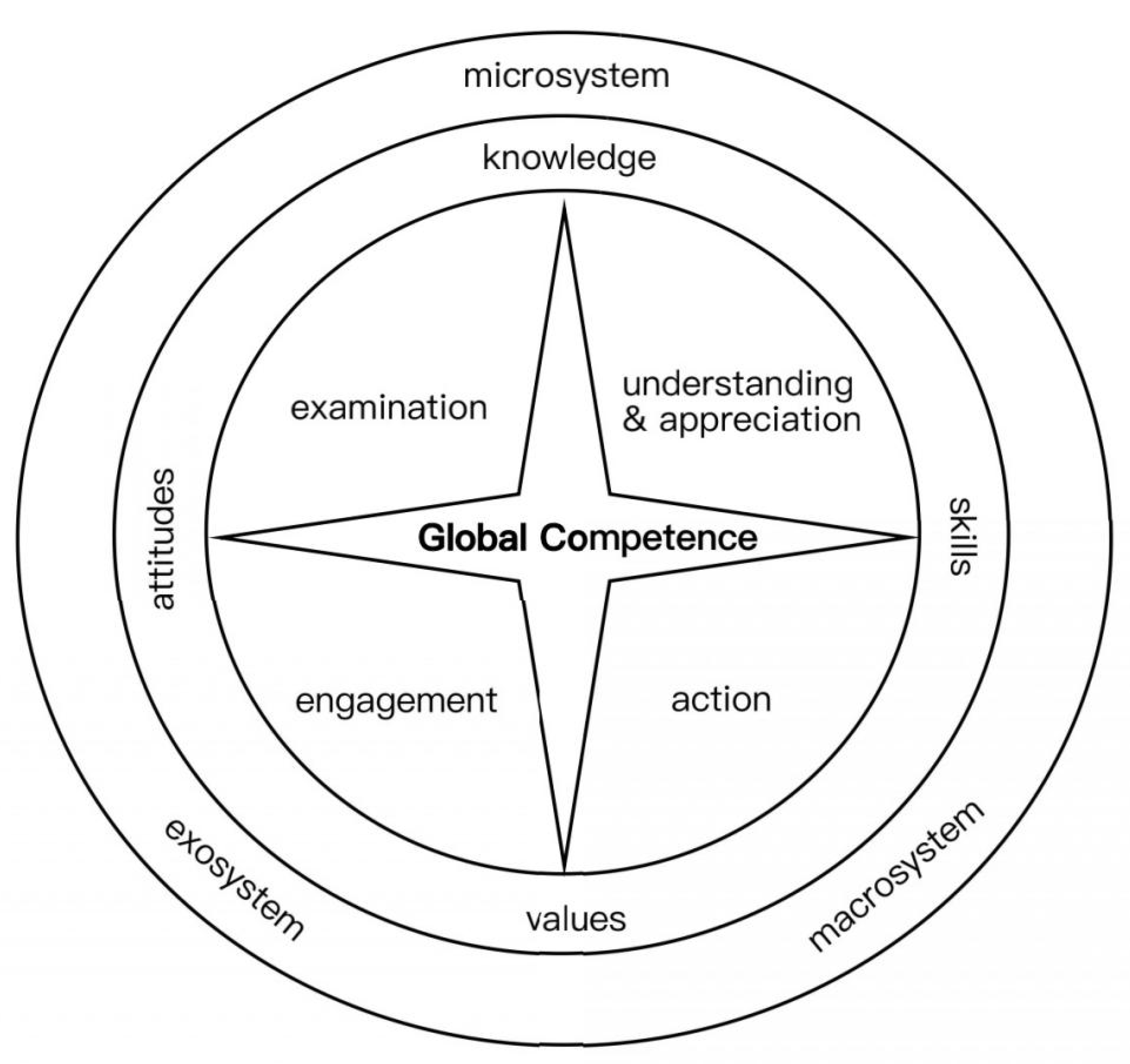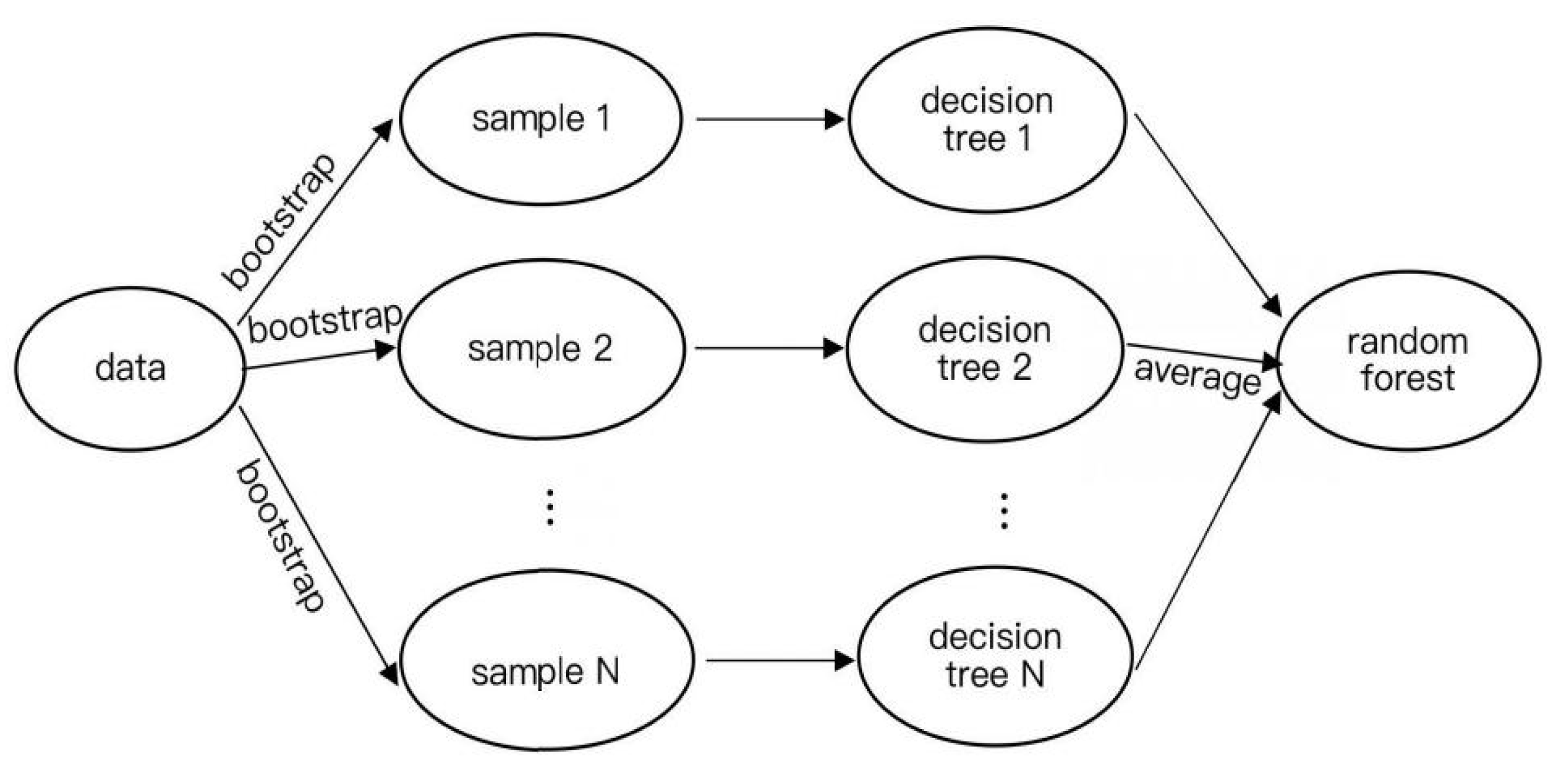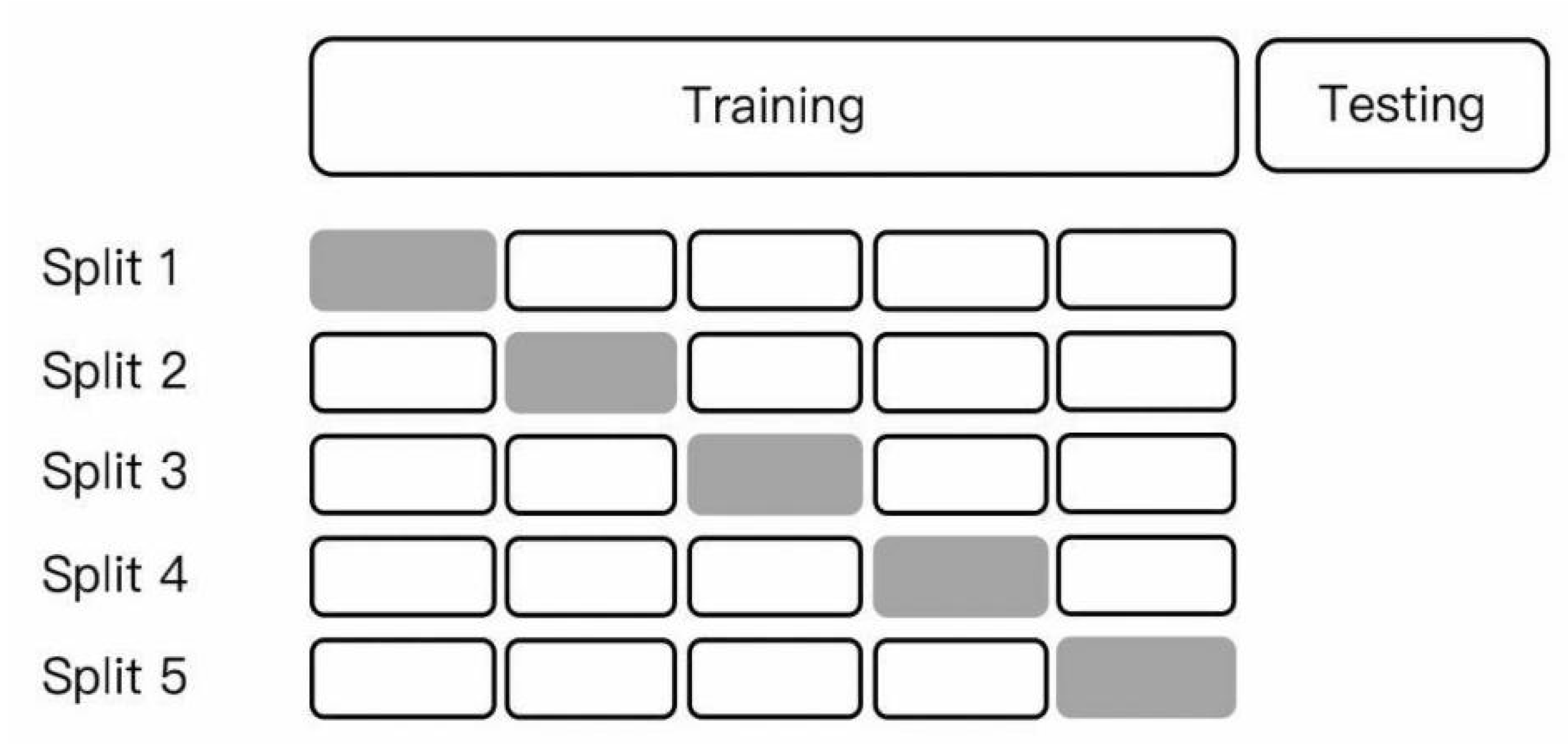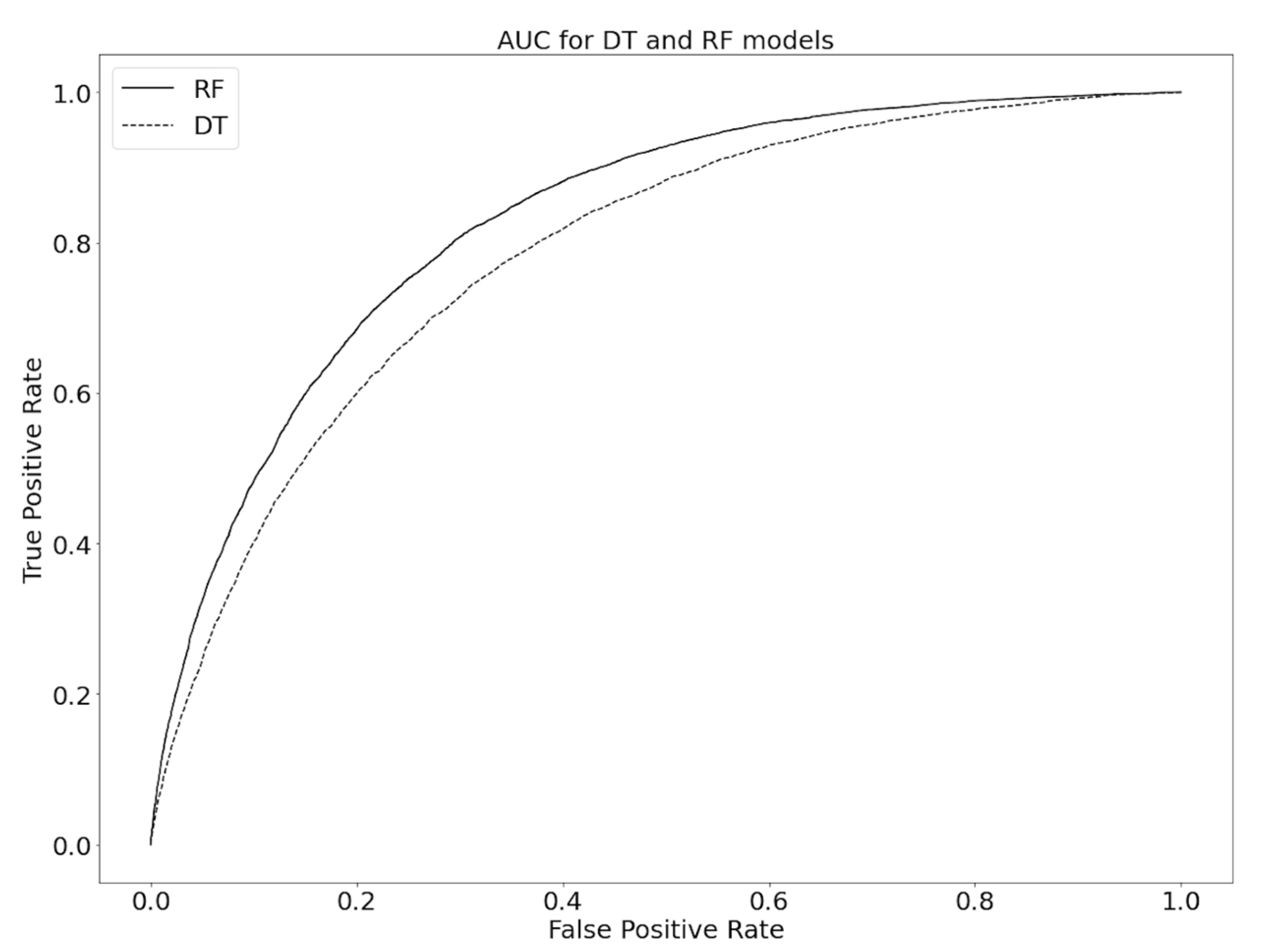A Classification Analysis of the High and Low Levels of Global Competence of Secondary Students: Insights from 25 Countries/Regions
Abstract
:1. Introduction
2. Literature Review
2.1. Relevant Factors of Global Competence
2.1.1. Student Factors
2.1.2. School Factors
2.2. Research Framework
- To what extent can the student and school factors extracted from global competence questionnaires discriminate students with high levels of global competence from those with low levels of global competence?
- What is the optimal set of factors with the most powerful impact on the discrimination of global competence discrepancies?
3. Materials and Methods
3.1. Data Sources
3.2. Variables
3.3. Models
3.3.1. Previous Prediction Models
3.3.2. Decision Trees
3.3.3. Random Forests
3.4. Data Preprocessing
3.5. Model Training
3.6. Model Evaluation
4. Results and Discussion
4.1. RQ 1 to What Extent Can the Student and School Factors Extracted from Global Competence Questionnaires Discriminate Students with High Levels of Global Competence from Those with Low Levels of Global Competence?
4.2. RQ 2 What Is the Optimal Set of Factors with the Most Powerful Impact on the Discrimination of Global Competence Discrepancies?
5. Conclusions
Author Contributions
Funding
Institutional Review Board Statement
Informed Consent Statement
Data Availability Statement
Conflicts of Interest
Appendix A
| Countries or Regions | ||||
|---|---|---|---|---|
| Kazakhstan | Serbia | Philippines | Lithuania | Brunei Darussalam |
| Panama | Colombia | Hong Kong | Croatia | Moscow Region (RUS) |
| Spain | Greece | Morocco | Korea | Tatarstan (RUS) |
| Albania | Slovak Republic | Thailand | Malta | Russian Federation |
| Latvia | Chile | Costa Rica | Indonesia | Chinese Taipei |
Appendix B
| Parameter | Decision Trees | Random Forests |
|---|---|---|
| max depth | 20 | / |
| criterion | entropy | entropy |
| min samples leaf | 200 | 5 |
| n estimators | / | 200 |
References
- Meng, Q.; Zhu, C.; Cao, C. Chinese international students’ social connectedness, social and academic adaptation: The mediating role of global competence. High Educ. 2017, 75, 131–147. [Google Scholar] [CrossRef]
- Hunter, B.; White, G.P.; Godbey, G. What does it mean to be globally competent? J. Stud. Int. Educ. 2006, 10, 267–285. [Google Scholar] [CrossRef]
- Murga-Menoyo, M.A. Educating for local development and global sustainability: An overview in Spain. Sustainability 2009, 1, 479–493. [Google Scholar] [CrossRef] [Green Version]
- OECD. PISA 2018 Global Competence Framework; OECD Publishing: Paris, France, 2019. [Google Scholar]
- Auld, E.; Morris, P. Science by streetlight and the OECD’s measure of global competence: A new yardstick for internationalisation? Policy Futures Educ. 2019, 17, 677–698. [Google Scholar] [CrossRef]
- Muñoz-La Rivera, F.; Hermosilla, P.; Delgadillo, J.; Echeverría, D. The Sustainable Development Goals (SDGs) as a basis for innovation skills for engineers in the Industry 4.0 context. Sustainability 2020, 12, 6622. [Google Scholar] [CrossRef]
- Zhao, H.Q.; Coombs, S. Intercultural teaching and learning strategies for global citizens: A Chinese EFL perspective. Teach. High. Educ. 2012, 17, 245–255. [Google Scholar] [CrossRef] [Green Version]
- Kang, J.H.; Kim, S.Y.; Jang, S.; Koh, A.R. Can college students’ global competence be enhanced in the classroom? The impact of cross- and intercultural online projects. Innov. Educ. Teach. Int. 2017, 55, 683–693. [Google Scholar]
- Meng, Q.; Zhu, C.; Cao, C. An exploratory study of Chinese university undergraduates’ global competence: Effects of internationalisation at home and motivation. High. Educ. Q. 2017, 71, 159–181. [Google Scholar] [CrossRef]
- Moody, C.T.; Rodas, N.V.; Norona, A.N.; Blacher, J.; Crnic, K.A.; Baker, B.L. Early childhood predictors of global competence in adolescence for youth with typical development or intellectual disability. Res. Dev. Disabil. 2019, 94, 103462. [Google Scholar] [CrossRef] [PubMed]
- He, Y.; Lundgren, K.; Pynes, P. Impact of short-term study abroad program: Inservice teachers’ development of intercultural competence and pedagogical beliefs. Teach. Teach. Educ. 2017, 66, 147–157. [Google Scholar] [CrossRef]
- Lee, C.P.; Curtis, J.H.; Curran, M.E. Stories of engagement: Preservice language teachers negotiate intercultural citizenship in a community-based English language program. Lang. Teach. Res. 2018, 22, 590–607. [Google Scholar]
- Zhang, M.X.; Zhu, F.J. Performance, Influence and Cultivating Strategies of Global Competence of 15-year-old Students from an International Perspective: Analysis based on PISA 2018 Results. Educ. Res. 2020, 26, 4–16. [Google Scholar]
- Alivernini, F. An exploration of the gap between highest and lowest ability readers across 20 countries. Educ. Stud. 2013, 39, 399–417. [Google Scholar] [CrossRef]
- Bronfenbrenner, U. The Ecology of Human Development: Experiments by Nature and Design; Harvard University Press: Cambridge, MA, USA, 1979. [Google Scholar]
- Redmond, M.L. Reaching global competence. Foreign Lang. Ann. 2014, 47, 1–2. [Google Scholar] [CrossRef]
- Semaan, G.; Yamazaki, K. The relationship between global competence and language learning motivation: An empirical study in critical language classrooms. Foreign Lang. Ann. 2015, 48, 511–520. [Google Scholar] [CrossRef]
- Tudge, J.; Mokrova, I.; Hatfield, B.E.; Karnik, R.B. Uses and misuses of bronfenbrenner’s bioecological theory of human development. J. Fam. Theory Rev. 2009, 1, 198–210. [Google Scholar] [CrossRef]
- Engel, L.C.; Rutkowski, D.; Thompson, G. Toward an international measure of global competence? A critical look at the PISA 2018 framework. Glob. Soc. Educ. 2019, 17, 117–131. [Google Scholar] [CrossRef]
- Salzer, C.; Roczen, N. Assessing global competence in PISA 2018: Challenges and approaches to capturing a complex construct. Int. J. Dev. Educ. Glob. Learn. 2018, 10, 5–20. [Google Scholar] [CrossRef]
- OECD. Lessons from PISA for Japan, Strong Performers and Successful Reformers in Education; OECD Publishing: Paris, France, 2012. [Google Scholar]
- Schleicher, A. PISA 2018: Insights and Interpretations; OECD Publishing: Paris, France, 2019. [Google Scholar]
- Fuller, W.A. Estimation for multiple phase samples. In Analysis of Survey Data; Wiley: Hoboken, NJ, USA, 2003; pp. 307–322. [Google Scholar]
- Cao, C.; Meng, Q. Exploring personality traits as predictors of English achievement and global competence among Chinese university students: English learning motivation as the moderator. Learn. Individ. Differ. 2020, 77, 101814. [Google Scholar] [CrossRef]
- Lee, E.; Jungdeok, K.; Sunyoung, S. An analysis on the relationship between multi-cultural experience and global competence of college students. J. Core Competency Educ. Res. 2019, 4, 47–69. [Google Scholar]
- Kim, K.; Kim, H.S.; Shim, J.; Park, J.S. A Study in the Early Prediction of ICT Literacy Ratings Using Sustainability in Data Mining Techniques. Sustainability 2021, 13, 2141. [Google Scholar] [CrossRef]
- Larose, D.; Larose, C. Discovering Knowledge in Data: An Introduction to Data Mining; Wiley: Hoboken, NJ, USA, 2014. [Google Scholar]
- Alivernini, F.; Manganelli, S. Country, school and students factors associated with extreme levels of science literacy across 25 countries. Int. J. Sci. Educ. 2015, 37, 1992–2012. [Google Scholar] [CrossRef]
- Rebai, S.; Yahia, F.B.; Essid, H. A graphically based machine learning approach to predict secondary schools performance in Tunisia. Socio-Econ. Plan. Sci. 2020, 70, 100724. [Google Scholar] [CrossRef]
- Chen, J.; Zhang, Y.; Wei, Y.; Hu, J. Discrimination of the contextual features of top performers in scientific literacy using a machine learning approach. Res. Sci. Educ. 2019, 1–30. [Google Scholar] [CrossRef]
- Gorostiaga, A.; Rojo-álvarez, J. On the use of conventional and statistical-learning techniques for the analysis of PISA results in Spain. Neurocomputing 2016, 171, 625–637. [Google Scholar] [CrossRef]
- Chen, J.; Zhang, Y.; Hu, J. Synergistic effects of instruction and affect factors on high- and low-ability disparities in elementary students’ reading literacy. Read. Writ. 2021, 34, 199–230. [Google Scholar] [CrossRef]
- Biau, G.; Scornet, E. A random forest guided tour. Off. J. Span. Soc. Stat. Oper. Res. 2016, 25, 197–227. [Google Scholar] [CrossRef] [Green Version]
- Güre, O.B.; Kayri, M.; Erdoğan, F. Analysis of factors effecting PISA 2015 mathematics literacy via educational data mining. Egitim Bilim. 2020, 45, 393–415. [Google Scholar]
- Qiao, X.; Jiao, H. Data mining techniques in analyzing process data: A didactic. Front. Psychol. 2018, 9, 2231. [Google Scholar] [CrossRef] [PubMed]
- Kang, H. The prevention and handling of the missing data. Korean J. Anesthesiol. 2013, 64, 402–406. [Google Scholar] [CrossRef] [PubMed]
- Mou, W.J.; Liu, Z.Q.; Luo, Y.; Zou, M.; Ren, C.; Zhang, C.Y.; Tian, Y.P. Development and cross–validation of prognostic models to assess the treatment effect of cisplatin/pemetrexed chemotherapy in lung adenocarcinoma patients. Med. Oncol. 2014, 31, 59. [Google Scholar] [CrossRef] [PubMed]
- Dosenbach, N.U.; Nardos, B.; Cohen, A.L.; Fair, D.A.; Power, J.D.; Church, J.A.; Nelson, S.M.; Wig, G.S.; Vogel, A.C.; Lessov-Schlaggar, C.N.; et al. Prediction of individual brain maturity using fMRI. Science 2010, 329, 1358–1361. [Google Scholar] [CrossRef] [PubMed] [Green Version]
- Cho, M.; Yoo, J. Exploring online students’ self-regulated learning with self-reported surveys and log files: A data mining approach. Interact. Learn. Environ. 2017, 25, 970–982. [Google Scholar] [CrossRef]
- Becket, N.; Brookes, M. Developing global competencies in graduates. J. Hosp. Leis. Sport Tour. Educ. 2012, 11, 79–82. [Google Scholar] [CrossRef]
- Blumenthal, P.; Grothus, U. Developing global competence in engineering students: U.S. and German approaches. Online J. Glob. Eng. Educ. 2008, 3, 1. [Google Scholar]
- Li, Y. Cultivating student global competence: A pilot experimental study. Decis. Sci. J. Innov. Educ. 2013, 11, 125–143. [Google Scholar] [CrossRef]
- Kerkhoff, S.N.; Cloud, M.E. Equipping teachers with globally competent practices: A mixed methods study on integrating global competence and teacher education. Int. J. Educ. Res. 2020, 103, 101629. [Google Scholar] [CrossRef] [PubMed]






| Level | Category | Factor |
|---|---|---|
| Student | Educational environment & experiences | Studying abroad [9] |
| Cross- and intercultural projects [8] | ||
| An EFL classroom [7] | ||
| Language proficiency | Language learning [16] | |
| Language barriers [8] | ||
| Use of language [1,17] | ||
| Life experiences | Mass media [8] | |
| Mass migration [8] | ||
| Time zone differences [8] | ||
| Contact with foreigners [9] | ||
| Family influences | Family background [13] | |
| Parenting [10] | ||
| School | Teachers | Instructional strategies [11] |
| Cultural awareness [12] | ||
| Rankings | School rankings [13] |
| Demographic Variables | High Achievers | Low Achievers |
|---|---|---|
| Student Number | 44,356 | 164,200 |
| Gender | ||
| Girl | 57.49% | 48.21% |
| Boy | 42.51% | 51.79% |
| Age | 14.75 (±0.58) | 14.47 (±0.73) |
| School Location | ||
| City (above 100,000) | 53.57% | 39.96% |
| Town (3000 to 100,000) | 42.45% | 47.51% |
| Village or rural area (below 3000) | 3.97% | 12.53% |
| School Type | ||
| Public school | 65.58% | 81.90% |
| Private school | 34.42% | 18.10% |
| Variable | Question | Value Scale | Value Range | Mean | SD |
|---|---|---|---|---|---|
| Student level | |||||
GCSELFEFF
| ST196Q02HA
| 1—I could not do this. 2—I would struggle to do this on my own. 3—I could do this with a bit of effort. 4—I could do this easily. | 1–4 | 2.69 | 0.95 |
ST196Q03HA
| 1–4 | 2.54 | 0.88 | ||
ST196Q04HA
| 1–4 | 2.89 | 0.88 | ||
ST196Q05HA
| 1–4 | 2.86 | 0.89 | ||
ST196Q06HA
| 1–4 | 2.70 | 0.90 | ||
ST196Q07HA
| 1–4 | 2.76 | 0.90 | ||
| School level | |||||
| Attention to global competence in the curriculum | SC167Q01HA
| 1—Yes 2—No | 1–2 | 1.45 | 0.50 |
SC167Q02HA
| 1–2 | 1.17 | 0.38 | ||
SC167Q03HA
| 1–2 | 1.26 | 0.44 | ||
SC167Q04HA
| 1–2 | 1.12 | 0.32 | ||
SC167Q05HA
| 1–2 | 1.11 | 0.31 | ||
SC167Q06HA
| 1–2 | 1.13 | 0.34 | ||
| Variable | Description | Formation |
|---|---|---|
| Student level | ||
| GCSELFEFF | Self-efficacy regarding global issues | GCSELFEFF |
| GCAWARE | Awareness of global issues | GCAWARE |
| PERSPECT | Perspective taking | PERSPECT |
| COGFLEX | Adaptability | COGFLEX |
| AWACOM | Awareness of intercultural communication | AWACOM |
| INTCULT | Interest in learning about other cultures | INTCULT |
| ST220Q02HA | Contact with people from other countries at school | ST220Q02HA |
| ST220Q04HA | Contact with people from other countries in your circle of friends | ST220Q04HA |
| RESPECT | Respect for people from other cultural backgrounds | RESPECT |
| GLOBMIND | Global mindedness | GLOBMIND |
| ATTIMM | Attitudes toward immigrants | ATTIMM |
| ST189Q01HA | Number of foreign languages learned at school | ST189Q01HA |
| ST177Q | Number of languages spoken | ST177Q01HA, ST177Q02HA, ST177Q03HA |
| ST221Q | Global competence activities at school | ST221Q01HA, ST221Q02HA… ST221Q11HA |
| School level | ||
| ST223Q | Intercultural attitudes of teachers | ST223Q02HA, ST223Q04HA… ST223Q08HA |
| SC159Q01HA | School with visiting teachers from other countries | SC159Q01HA |
| SC165Q | Multicultural/intercultural education practices at school | SC165Q01HA, SC165Q02HA… SC165Q10HA |
| SC166Q | School principal’ s perception of teachers’ intercultural beliefs | SC166Q02HA, SC166Q03HA… SC166Q06HA |
| SC167Q | Attention to global competence in the curriculum | SC167Q01HA, SC167Q02HA… SC167Q06HA |
| SC158Q | Attention to global challenges and trends in the curriculum | SC158Q01HA, SC158Q02HA… SC158Q12HA |
| SC150Q | Language policies for nonnative speakers | SC150Q01IA, SC150Q02IA, SC150Q05IA |
| Confusion Matrix | Predicted Value | ||
|---|---|---|---|
| Positive | Negative | ||
| Real Value | Positive | True Positive 1 (TP) | False Negative (FN) |
| Negative | False Positive (FP) | True Negative (TN) | |
| Model | Training | Testing | |||
|---|---|---|---|---|---|
| Accuracy (%) | Accuracy (%) | Precision (%) | Recall (%) | F-Score (%) | |
| Decision Tree | 78.2 | 80.05 | 77.11 | 80.05 | 77.13 |
| Random Forest | 82.7 | 81.59 | 79.46 | 81.59 | 78.53 |
| Ranking | Decision Tree | Random Forest | ||
|---|---|---|---|---|
| Variable | Coefficient | Variable | Coefficient | |
| 1 | ST223Q | 0.2480 | GCSELFEFF | 0.0972 |
| 2 | GCSELFEFF | 0.1518 | ST223Q | 0.0855 |
| 3 | AWACOM | 0.1449 | AWACOM | 0.0830 |
| 4 | ATTIMM | 0.0841 | GCAWARE | 0.0795 |
| 5 | ST221Q | 0.0686 | ATTIMM | 0.0631 |
| 6 | GCAWARE | 0.0583 | RESPECT | 0.0608 |
| 7 | ST177Q | 0.0568 | GLOBMIND | 0.0573 |
| 8 | RESPECT | 0.0548 | COGFLEX | 0.0546 |
| 9 | ST220Q | 0.0312 | PERSPECT | 0.0512 |
| 10 | SC159Q01HA | 0.0250 | ST221Q | 0.0503 |
| 11 | ST222Q | 0.0151 | INTCULT | 0.0487 |
| 12 | GLOBMIND | 0.0101 | ST177Q | 0.0453 |
| 13 | COGFLEX | 0.0099 | ST222Q | 0.0360 |
| 14 | SC158Q | 0.0096 | ST220Q | 0.0338 |
| 15 | INTCULT | 0.0076 | SC165Q | 0.0287 |
| 16 | PERSPECT | 0.0074 | SC166Q | 0.0261 |
| 17 | SC150Q | 0.0072 | SC150Q | 0.0250 |
| 18 | SC166Q | 0.0034 | SC158Q | 0.0213 |
| 19 | ST189Q01HA | 0.0024 | SC167Q | 0.0197 |
| 20 | SC165Q | 0.0020 | ST189Q01HA | 0.0178 |
| 21 | SC167Q | 0.0016 | SC159Q01HA | 0.0160 |
Publisher’s Note: MDPI stays neutral with regard to jurisdictional claims in published maps and institutional affiliations. |
© 2021 by the authors. Licensee MDPI, Basel, Switzerland. This article is an open access article distributed under the terms and conditions of the Creative Commons Attribution (CC BY) license (https://creativecommons.org/licenses/by/4.0/).
Share and Cite
Hu, X.; Hu, J. A Classification Analysis of the High and Low Levels of Global Competence of Secondary Students: Insights from 25 Countries/Regions. Sustainability 2021, 13, 11053. https://doi.org/10.3390/su131911053
Hu X, Hu J. A Classification Analysis of the High and Low Levels of Global Competence of Secondary Students: Insights from 25 Countries/Regions. Sustainability. 2021; 13(19):11053. https://doi.org/10.3390/su131911053
Chicago/Turabian StyleHu, Xiaoyue, and Jie Hu. 2021. "A Classification Analysis of the High and Low Levels of Global Competence of Secondary Students: Insights from 25 Countries/Regions" Sustainability 13, no. 19: 11053. https://doi.org/10.3390/su131911053
APA StyleHu, X., & Hu, J. (2021). A Classification Analysis of the High and Low Levels of Global Competence of Secondary Students: Insights from 25 Countries/Regions. Sustainability, 13(19), 11053. https://doi.org/10.3390/su131911053






